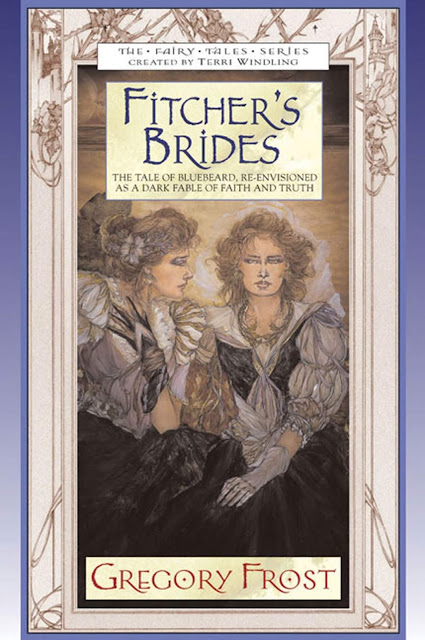"Fitcher's Brides" by Gregory Frost (published 2003)
| “Then Kate sank back upon her pillows and allowed herself the luxury of terror,” reads the closing sentence of Chapter 29 in Gregory Frost’s “Fitcher’s Brides: The Tale of Bluebeard, Re-Envisioned As A Dark Fable of Faith and Truth”. Indeed, this is much what reading the book is like: allowing yourself the luxury of terror while witnessing the effects of a twisted, power-obsessed, murderous preacher’s sermon grasping the minds of the spiritually weak community, all the while knowing that innocent women will be tortured under that same preacher’s hands. Why continue reading? Something about the bone-chilling revelation about the dirtier nature of organized religion (its power to repress, to oppress, and to control) urges you to read on, knowing deep down that some of this fiction has truth within it’s pages. Luckily, like Kate at that moment in the story, you are snuggled and safe under the covers of a warm bed. But also like Kate, you are somewhat unsure of what tomorrow might bring, though surely not the apocalypse. Right? “Fitcher’s Brides” is based off of the fairy-tale “Bluebeard” by Charles Perrault (the same person who created the story of “Cinderella” as we know it today). Some say the book is about the perils of curiosity (a “curiosity killed the cat” type of deal) and/or a cautionary tale about marriage and its discontents. What’s great about this book by Gregory Frost is that it is part of Terri Windling’s Fairy-Tale Series - a series consisting of eight full-length novels of fairy-tales re-written and revised. All of them can be read in any order whatsoever. Each of these books has an introduction by Windling from her desk at the Endicott Studio Of Mythic Arts. The introduction will give a bit of history, literary criticism, and contextual analysis in preparation for the “new” fairy-tale which follows. Fitcher, the murderous preacher in this novel, is part of the New York world during the mid-19th Century (1843); a time of religious fervor, a time of people coming and residing within the state from all over the globe and settling into the land, creating towns, farms, and the communities to go along with it. The Charter girls arrive in New York because of Fitcher. The Charter girls are three sisters named Vernelia, Amy, and Kate, who, at the time of their arrival, are bonding ever more closely after their mother’s death. Their father, unluckily for all of them, remarried to a woman who grasps religion a bit too tightly. Her adoration for one preacher is particularly strong - Fitcher. The newly married Lavinia (the new wife and mother) drags Mr. Charter into the vortex of this religious insanity, and all of them succumb to the temptation of blind faith, particularly to the idea, presented as fact by Reverend Fitcher, that the world will end on an exact date (revealed in the book) in the month of October. As the world prepares for it’s end, Fitcher has created a haven for his followers, where everyone has a job to do, eats on schedule and without speaking to one another, where men are separated from the women, and where, occasionally, a death by hanging occurs. Some kind of haven! From what? God only knows. Daily, Reverend Fitcher preaches to his flock. Many times he preaches against worldly desires and the love of worldly things. Yet his luxurious home, his actions, and his demeanor suggest he believes otherwise. However, it seems that this Reverend wants something, despite all his blatant inconsistencies and horrific deeds. He wants to be taken in by God up into heaven. He wants to be saved from the world. From his sinful, dirty flock. But how does he expect to do that after living such a life? Will he be forgiven? Gregory Frost’s “Fitcher’s Brides” is full of the romance and sensuality key to fairy-tales. Instead of children’s book pictures, there are lush, magical, and vivid descriptions of dreams, architecture (both internal and external), emotion, and action. The violence in the book is explicit, and Frost has a way of telling the story with a keen knowledge and awareness of human psychology – the darker parts as well as the simpler ones, drawing one’s attention to how there is a perversity within all of us, something that is not entirely our fault, something that, at the end of the day, a *good* person will overcome. Another facet about this story that attention should be drawn to is that “Fitcher’s Brides” is a fairy-tale about bravery. While two sisters are killed, those two sisters live strong and courageously while they are alive, using the best of their wits and inner strength to conquer the evil within. And the best part is that the last sister conquers this evil physically, concretely… okay, maybe with the help of some magic, but she proves that she can save herself as well as her sisters despite all costs. It is Kate, the one who took some time to “allow herself the luxury of terror”, who brings everyone back to reality. |




Comments
Post a Comment